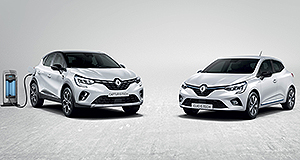Make / Model Search
Future models - RenaultRenault unveils Clio and Captur hybrid duoRenault enters the growing hybrid market with new Clio and Captur10 Jan 2020 AS DEMAND for hybrids grows stronger and emission regulations tighten, more manufacturers are entering the eco-market including Renault, upping its game with the new Clio E-Tech and Captur E-Tech Plug-in.
Debuting overnight at the Brussels Motor Show, the new hybrids share a 1.6-litre four-cylinder petrol engine coupled to two electric motors, good for 103kW of power in the Clio and 118kW in the Captur.
The whole setup is then paired with a new multi-mode clutchless gearbox with both featuring regenerative braking.
Where the two models differ is in their recharge systems with the Clio E-Tech being a “full-hybrid” (HEV) with a with a 1.2kWh battery while the Captur E-Tech utilises a plug-in hybrid system (PHEV) and steps things up with a 9.8kWh battery.
Renault says the E-Tech system “guarantees electric-only start up every time, enjoyable driveability in all circumstances, excellent fuel efficiency thanks to its smart multimodal, gearbox, efficient regenerative braking and high capacity battery recharging”.
For the Clio, this equates to a claimed efficiency improvement of up to 40 per cent on the urban cycle compared to an equivalent internal combustion engine due to being able to be driven in all-electric mode up to 80 per cent of the time in the city.
Standard equipment on the Clio includes Renault’s Highway and Traffic Jam Companion, something it describes as its first step towards autonomous vehicles as well as its new Easy Link multimedia system, accessed via a 7.0-inch horizontal or 9.3-inch vertical screen.
Also included is a new 7.0-inch ‘smart cockpit’ digital instrument cluster capable of displaying a range of extra information such as the battery level.
Thanks to its bigger battery, the Captur is able to be driven in all-electric mode for up to 50km and reach 135km/h – compared to the Clio’s 75km/h – with the range increasing to 65km in the city.
Fuel economy is claimed to be as low as 1.5 litres per 100km.
Its initial launch trim is based on the higher-specified petrol variants, though Renault says the hybrid setup will eventually trickle down and be available in lower trim levels.
Coming as standard from launch is the French marque’s Multi-Sense system featuring Pure, Sport and E-Save drive modes each dedicated to either efficiency or performance and all accessible via the infotainment screen menus.
Drivers are treated to a larger, 10.3-inch version of the smart cockpit and a few more display features including battery life, recharge time, flow exchanges, energy recovery and current charge level of the electric motor battery.
GoAuto has contacted Renault Australia to confirm if and when the E-Techs will be lobbing in Australia.  Read more7th of January 2020  Renault retrofits smartphone mirroring on KoleosApple CarPlay/Android Auto introduced to MY18 Koleos by Renault Australia19th of December 2019  PSA, FCA sign on the dotted lineMerger between PSA and FCA confirmed, formation of mega-group to take 12-15 monthsAll future models Alfa Romeo Alfa Romeo Abarth Abarth Alpine Alpine Alpina Alpina Audi Audi Aston Martin Aston Martin BMW BMW Bentley Bentley Chery Chery Brabham Brabham Chrysler Chrysler Chevrolet Chevrolet Cupra Cupra Citroen Citroen DS DS Dodge Dodge Fiat Fiat Ferrari Ferrari Foton Foton Ford Ford Great Wall Great Wall FPV FPV Haval Haval GWM GWM Honda Honda Holden Holden Hummer Hummer HSV HSV Infiniti Infiniti Hyundai Hyundai Jaguar Jaguar Isuzu Isuzu Kia Kia Jeep Jeep Land Rover Land Rover Lamborghini Lamborghini Lexus Lexus LDV LDV Mahindra Mahindra Lotus Lotus Mazda Mazda Maserati Maserati Mercedes-AMG Mercedes-AMG McLaren McLaren MG MG Mercedes-Benz Mercedes-Benz Mitsubishi Mitsubishi Mini Mini Opel Opel Nissan Nissan Peugeot Peugeot Pagani Pagani Proton Proton Porsche Porsche Renault Renault Ram Ram Rover Rover Rolls-Royce Rolls-Royce Skoda Skoda Saab Saab SsangYong SsangYong Smart Smart Suzuki Suzuki Subaru Subaru Toyota Toyota Tesla Tesla Volvo VolvoMotor industry news |
Click to shareRenault modelsResearch Renault All future models Alfa Romeo Alfa Romeo Abarth Abarth Alpine Alpine Alpina Alpina Audi Audi Aston Martin Aston Martin BMW BMW Bentley Bentley Chery Chery Brabham Brabham Chrysler Chrysler Chevrolet Chevrolet Cupra Cupra Citroen Citroen DS DS Dodge Dodge Fiat Fiat Ferrari Ferrari Foton Foton Ford Ford Great Wall Great Wall FPV FPV Haval Haval GWM GWM Honda Honda Holden Holden Hummer Hummer HSV HSV Infiniti Infiniti Hyundai Hyundai Jaguar Jaguar Isuzu Isuzu Kia Kia Jeep Jeep Land Rover Land Rover Lamborghini Lamborghini Lexus Lexus LDV LDV Mahindra Mahindra Lotus Lotus Mazda Mazda Maserati Maserati Mercedes-AMG Mercedes-AMG McLaren McLaren MG MG Mercedes-Benz Mercedes-Benz Mitsubishi Mitsubishi Mini Mini Opel Opel Nissan Nissan Peugeot Peugeot Pagani Pagani Proton Proton Porsche Porsche Renault Renault Ram Ram Rover Rover Rolls-Royce Rolls-Royce Skoda Skoda Saab Saab SsangYong SsangYong Smart Smart Suzuki Suzuki Subaru Subaru Toyota Toyota Tesla Tesla Volvo VolvoMotor industry news |











Facebook Twitter Instagram